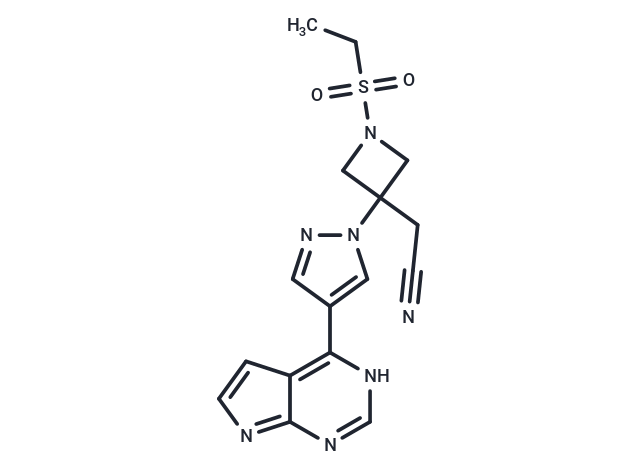Shopping Cart
Remove All Your shopping cart is currently empty
Your shopping cart is currently empty
Baricitinib (INCB028050) is a JAK1 and JAK2 inhibitor (IC50=5.9/5.7 nM) with selective and oral activity. Baricitinib has potential anti-inflammatory, immunomodulatory and anti-tumor activity.

| Pack Size | Price | USA Warehouse | Global Warehouse | Quantity |
|---|---|---|---|---|
| 5 mg | $43 | In Stock | In Stock | |
| 10 mg | $67 | In Stock | In Stock | |
| 25 mg | $92 | In Stock | In Stock | |
| 50 mg | $117 | In Stock | In Stock | |
| 100 mg | $147 | In Stock | In Stock | |
| 200 mg | $198 | In Stock | In Stock | |
| 500 mg | $328 | In Stock | In Stock | |
| 1 mL x 10 mM (in DMSO) | $63 | In Stock | In Stock |
| Description | Baricitinib (INCB028050) is a JAK1 and JAK2 inhibitor (IC50=5.9/5.7 nM) with selective and oral activity. Baricitinib has potential anti-inflammatory, immunomodulatory and anti-tumor activity. |
| Targets&IC50 | TYK2:53 nM, JAK1:5.9 nM, JAK3:> 400 nM, JAK2:5.7 nM |
| In vitro | METHODS: PBMC cells were pre-incubated with Baricitinib (0-10,000 nM) for 10 min, and the cells were stimulated with IL-6 (10 ng/mL) for 48 h. Related factors were detected by ELISA assay. RESULTS: In PBMC, Baricitinib inhibited IL-6-stimulated phosphorylation of the classical substrate STAT3 and subsequent production of the chemokine MCP-1 with IC50 values of 44 nM and 40 nM, respectively.[1] METHODS: CD19+ B cells were treated with IgM antibody (1 µg/mL), sCD40L (250 ng/mL), IL-4 (100 ng/mL), and Baricitinib (0.05-5 µM) for 2-5 days, and gene expression levels were measured using real-time PCR. RESULTS: After two days of stimulation, Baricitinib was found to significantly inhibit the expression level of Aicda in a dose-dependent manner, while the expression level of Bcl6 was increased. After five days of stimulation, the expression levels of Xbp1 and Irf4 were also significantly reduced. IgG production measured from the supernatant under the same conditions was significantly reduced depending on the increase in Baricitinib dose after two and five days of stimulation, respectively. [2] |
| In vivo | METHODS: To investigate the potential therapeutic utility in autoimmune arthritis, Baricitinib (1-10 mg/kg) was administered orally to DBA/1j mice with collagen-induced arthritis (CIA) twice daily for 15 days. RESULTS: Clinical signs of disease improved as early as 4 days after administration, and at study termination, clinical scores were reduced by 19%, 67%, and 61%, respectively, in a dose-dependent manner compared to the vector control group. [1] |
| Kinase Assay | Enzyme assays are performed using a homogeneous time-resolved fluorescence assay with recombinant epitope tagged kinase domains (JAK1, 837-1142; JAK2, 828-1132; JAK3, 718-1124; Tyk2, 873-1187) or full-length enzyme (cMET and Chk2) and peptide substrate. Each enzyme reaction is performed with or without test compound (11-point dilution), JAK, cMET, or Chk2 enzyme, 500 nM (100 nM for Chk2) peptide, ATP (at the Km specific for each kinase or 1 mM), and 2.0% DMSO in assay buffer. The calculated IC50 value is the compound concentration required for inhibition of 50% of the fluorescent signal. Additional kinase assays are performed at Cerep using standard conditions at 200 nM. Enzymes tested included: Abl, Akt1, AurA, AurB, CDC2, CDK2, CDK4, CHK2, c-kit, EGFR, EphB4, ERK1, ERK2, FLT-1, HER2, IGF1R, IKKα, IKKβ, JNK1, Lck, MEK1, p38α, p70S6K, PKA, PKCα, Src, and ZAP70[1]. |
| Cell Research | Baricitinib(INCB 028050) is dissolved in stock solutions, and then diluted with appropriate media before use[1]. Human PBMCs are isolated by leukapheresis followed by Ficoll-Hypaque centrifugation. For the determination of IL-6-induced MCP-1 production, PBMCs are plated at 3.3×105 cells per well in RPMI 1640+10% FCS in the presence or absence of various concentrations of INCB028050 (1 nM, 10 nM, 100 nM, 1 μM, and 10 μM). Following preincubation with compound for 10 min at room temperature, cells are stimulated by adding 10 ng/mL human recombinant IL-6 to each well. Cells are incubated for 48 h at 37°C, 5% CO2. Supernatants are harvested and analyzed by ELISA for levels of human MCP-1. The ability of INCB028050 to inhibit IL-6-induced secretion of MCP-1 is reported as the concentration required for 50% inhibition (IC50). Proliferation of Ba/F3-TEL-JAK3 cells is performed over 3 d using Cell-Titer Glo[1]. |
| Synonyms | LY3009104, INCB028050 |
| Molecular Weight | 371.42 |
| Formula | C16H17N7O2S |
| Cas No. | 1187594-09-7 |
| Smiles | CCS(=O)(=O)N1CC(CC#N)(C1)n1cc(cn1)-c1[nH]cnc2nccc12 |
| Relative Density. | 1.56 g/cm3 |
| Storage | Powder: -20°C for 3 years | In solvent: -80°C for 1 year | Shipping with blue ice/Shipping at ambient temperature. | |||||||||||||||||||||||||||||||||||
| Solubility Information | H2O: < 1 mg/mL (insoluble or slightly soluble) Ethanol: < 1 mg/mL (insoluble or slightly soluble) DMSO: 250 mg/mL (673.09 mM), Sonication is recommended. | |||||||||||||||||||||||||||||||||||
| In Vivo Formulation | 10% DMSO+40% PEG300+5% Tween 80+45% Saline: 6.9 mg/mL (18.58 mM), Suspension. Please add the solvents sequentially, clarifying the solution as much as possible before adding the next one. Dissolve by heating and/or sonication if necessary. Working solution is recommended to be prepared and used immediately. The formulation provided above is for reference purposes only. In vivo formulations may vary and should be modified based on specific experimental conditions. | |||||||||||||||||||||||||||||||||||
Solution Preparation Table | ||||||||||||||||||||||||||||||||||||
DMSO
| ||||||||||||||||||||||||||||||||||||
| Size | Quantity | Unit Price | Amount | Operation |
|---|

Copyright © 2015-2025 TargetMol Chemicals Inc. All Rights Reserved.